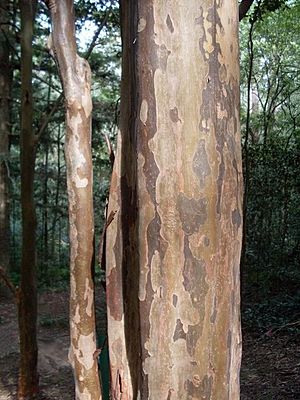Backhousia subargentea facts for kids
Quick facts for kids Backhousia subargentea |
|
|---|---|
 |
|
| Conservation status | |
| Scientific classification | |
| Genus: |
Backhousia
|
| Species: |
subargentea
|
| Synonyms | |
|
|
The Backhousia subargentea (also known as Choricarpia subargentea) is a special and rare tree from the Australian rainforest. It's often called giant ironwood, ironwood box, scrub ironwood, or lancewood.
You can find this tree growing in specific areas. It lives near Mullumbimby in north-eastern New South Wales. It also grows from Boonah to Imbil in south-eastern Queensland. In New South Wales, it likes dry rainforests on hillsides. It often grows near other trees like the shatterwood and wild quince.
Contents
About the Giant Ironwood Tree
What it Looks Like
The Backhousia subargentea is usually a small to medium-sized tree. Sometimes it can grow up to 30 metres tall. But in New South Wales, it's often smaller, only about 8 metres high. Its trunk can be about 20 centimetres wide.
The trunk of this tree is often not straight. It can have many stems and be a bit crooked. The bark can be smooth and shiny. It might be an attractive orange-brown or pink-purple colour. Sometimes it looks green where old bark has recently fallen off. The bark can also shed in patches. This makes the trunk look mottled, a bit like the spotted gum or leopardwood trees.
Its Leaves, Flowers, and Fruit
The leaves of the giant ironwood grow in pairs, one opposite the other. They are simple and have smooth edges. They are usually shaped like a spear or are broad with a fine tip. Each leaf is about 4 to 8 centimetres long. The top of the leaf is a shiny dark green. The underside is a greyish-fawn colour.
If you crush the leaves, they smell like eucalyptus. This is because both plants are part of the myrtle family. You can see tiny oil dots on the leaves if you use a magnifying glass. The main vein and side veins are only easy to see on the top of the leaf. A special vein runs around the edge of the leaf, about 2 millimetres from the very edge. The leaf stalks are short, about 5 to 10 millimetres long. They often have small, scaly bits on them.
The flowers are white and grow close together in round clusters. They are small, about 5 to 8 millimetres long. These flowers usually appear in April. The fruit grows about six months later. It's a small, dry capsule, about 5 millimetres wide. It sits on a stalk that is 6 to 10 millimetres long.
Why This Tree is Important
Because the Backhousia subargentea is so rare, it's not commonly used. However, if it were more common, it would make a beautiful tree for gardens or parks. Its unique trunk and lovely leaves would be very attractive.
Find Out More
- PlantNET - The Plant Information Network System of Botanic Gardens Trust, Sydney, Australia - [1]
- NSW Threatened Species: [2]


